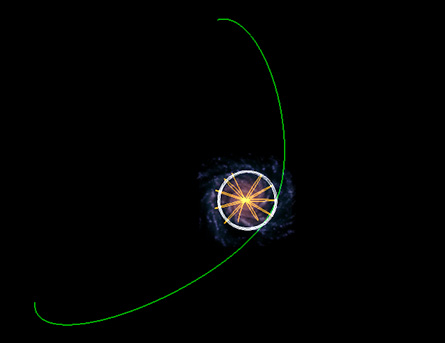To see video of the orbits of these subdwarf stars, click here.

PASADENA, Calif. — Even the most unassuming neighbor can hide a giant secret. New calculations of the orbit of a dim, extremely low-mass star just 300 light-years from the solar system suggest the body may be a runaway from another galaxy.
After analyzing the high speed and direction of motion of the tiny star, Adam Burgasser of MIT and his colleagues reported June 9 at a meeting of the American Astronomical Society that the object’s orbit takes it up to 200,000 light-years away from the Milky Way’s center. That’s not only farther than the visible outlines of the galaxy but also farther than the outlines of the very nearest galactic neighbors, indicating that the star may have originated from a galaxy beyond the Milky Way.
The researchers propose that the star, first discovered in 2003 and dubbed 2MASS 1227-0447, may have come from a small galaxy that ventured close enough to the Milky Way to be ripped apart by gravitational forces. Although astronomers have previously identified streams of distant, massive stars in the Milky Way that originated from other gobbled-up galaxies, 2MASS 1227-0447 is the first nearby, low-mass star believed to have such a lineage. The star’s unusually low abundance of elements heavier than hydrogen and helium also suggests an alien origin, Burgasser said.
The star is one of only several dozen low-temperature, low-mass stars, called ultracool subdwarfs, identified in the Milky Way. Robyn Sanders of MIT analyzed the orbits of about 24 of these stars and found that they whiz past the sun at speeds of up to 500 kilometers per second. Several of the stars dive into the Milky Way’s center on elongated paths that take them thousands of light-years above and below the disk of the galaxy before returning to the disk. But only 2MASS 1227-0447 seems to have an orbit that traces back to a region far enough from the Milky Way’s disk to have once resided in a different galaxy.







